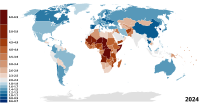
Photo from wikipedia
Background Even though the total fertility rate (TFR) has decreased significantly over the past decades in many countries, it has remained stable in sub-Saharan African (SSA) countries. However, there is… Click to show full abstract
Background Even though the total fertility rate (TFR) has decreased significantly over the past decades in many countries, it has remained stable in sub-Saharan African (SSA) countries. However, there is variation among the sub-regions and inhabitants of SSA. Therefore, this study aimed to conduct a meta-analysis of demographic and health surveys (DHS) to estimate the pooled level of TFR in SSA and to depict sub-regional and inhabitant differences. Methods The data source for this study was the standard Demographic and Health Survey datasets of 33 sub-Saharan African countries, accessed through www.meaasuredhs.com between 2010 and 2018. The point estimate of the total fertility rate with its corresponding standard error in each sub-Saharan African country was estimated using the DHS.rates R package. Using the point estimate of the TFR with the standard error of each country, the pooled estimate of the TFR was generated by the metan STATA command. Results The study comprised 1,324,466 live births in total. The pooled estimate of sub-Saharan Africa's overall fertility rate was five children per woman (95% CI: 4.63–5.37). Consequently, the pooled estimate of total fertility for people living in urban and rural areas was 3.90 (95% CI: 3.60–4.21) and 5.82 (95% CI: 5.43–6.21) children per woman, respectively. In sub-group analysis, the pooled estimates of the TFR for the East African, Central African, Southern African, and West African regions, respectively, were 4.74, 5.59, 3.18, and 5.38 children per woman. Total fertility rates were greater in low-income nations (5.45), lower-middle-income countries (4.70), and high-middle-income countries (3.80). Conclusions SSA has a relatively high total fertility rate. The regions of West and Central Africa have the highest overall fertility rate. The fertility rate is higher in countries with a large rural population and low income. Strategies should be developed to address this public health concern, especially in rural Central and Western Africa.
Journal Title: Frontiers in Public Health
Year Published: 2023
Link to full text (if available)
Share on Social Media: Sign Up to like & get
recommendations!